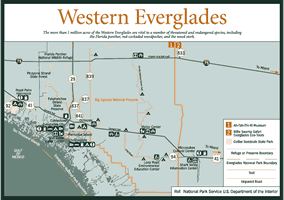
The area known as the Western Everglades includes Florida's "other" great
watershed. [Fig.
15] Spanning an area roughly from the Okaloacoochee Slough
headwaters near Immokalee to the coastal estuaries of southwestern Florida,
the Western Everglades encompasses more than 1,000,000 acres of extensive wet
prairies, pine islands, cypress strands, backcountry waterways, and mangrove
forests. 
Much like the eastern side of the Everglades, the general geologic structure of the Western Everglades is of a large, barely sloping watershed where seasonal rainfall travels through a system of sloughs and across wetland prairies until it finally reaches the tidal mangrove estuary. The seasonal wet and dry patterns define and maintain the varied habitats.
The extraordinary biological richness and diversity of these habitats is vital to a number of threatened and endangered species, including the Florida panther, redcockaded woodpecker, wood stork, and West Indian manatee. The region contains a mosaic of relatively new public land holdings, the Big Cypress National Preserve, the Fakahatchee Strand State Preserve, the Picayune Strand State Forest, the Panther National Wildlife Refuge, and the famous Ten Thousand Islands region of Everglades National Park. There is also a 69,900-acre Seminole Indian Reservation and a 76,800-acre Miccosukee Indian Reservation in part of the swamp.
Because of the widespread attention being paid to the problems affecting the imperiled river of grass in the Eastern Everglades, the Western Everglades has earned the nickname "Forgotten Everglades" from some conservationists. Nevertheless, development along the southwestern Florida coast, one of the fastest growing areas in the country, is having an impact on the remaining natural lands in the Western Everglades. Water quality has declined in estuarine areas, along with changes in the timing and flow of freshwater.
Fortunately, major conservation organizations have recognized that the time to act is long before environmental problems reach a critical stage like they have elsewhere in the Everglades. The National Wildlife Federation and the Florida Wildlife Federation (FWF), have opened a joint office in Naples and are now working to enhance public and government awareness of the importance of protecting the Western Everglades. (For more information on the natural and human history of the Everglades, see the introduction to the Florida Everglades: Everglades National Park to Shark Valley, page 153.)